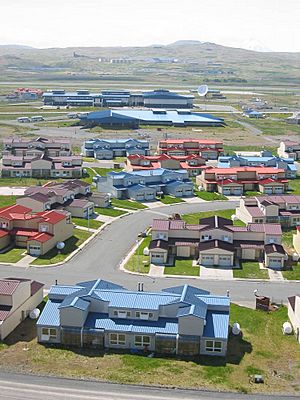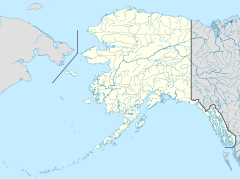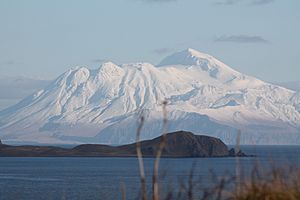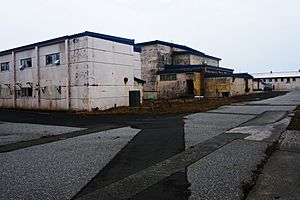Adak, Alaska facts for kids
Quick facts for kids
Adak, Alaska
|
|
|---|---|

Adak in 2006
|
|
| Country | |
| State | Alaska |
| Census Area | Aleutians West |
| Incorporated | 2001 |
| Area | |
| • Total | 71.47 sq mi (185.10 km2) |
| • Land | 32.43 sq mi (84.00 km2) |
| • Water | 39.03 sq mi (101.10 km2) |
| Elevation | 164 ft (50 m) |
| Population
(2020)
|
|
| • Total | 171 |
| • Density | 5.27/sq mi (2.04/km2) |
| Time zone | UTC−10 (Hawaii-Aleutian (HST)) |
| • Summer (DST) | UTC−9 (HDT) |
| ZIP Code |
99546
|
| Area code(s) | 907 |
| FIPS code | 02-00065 |
| GNIS feature ID | 1418109 |
| Website | adak-ak.gov |
Adak (/ˈeɪdæk/; Aleut: Adaax, pronounced /ˈaðɑχ/), formerly Adak Station, is a city located on Adak Island, in the Aleutians West Census Area, Alaska, United States. At the 2020 census, the population was 171, down from 326 in 2010. It is the westernmost municipality in the United States and the southernmost city in Alaska. (See Extreme points of the United States.) The city is the former location of the Naval Air Facility Adak, NAVFAC Adak.
Contents
Geography
Adak is located on Kuluk Bay, on Adak Island, in the Andreanof Islands group of the Aleutian Islands Recording District, and in the 3rd Judicial District. It lies 1,200 miles (1,930 km) southwest of Anchorage and 450 miles (724 km) west of Dutch Harbor at 51.872° North, 176.636° West (Sec. 10, T096S, R195W, Seward Meridian), near the Russian end of the arc that makes up this volcanic island chain. Flight time to Anchorage is 3 hours or longer, depending on weather. Adak is the southernmost community in Alaska and on the same latitude as Haida Gwaii in Canada, and London, England. It is less than three degrees of latitude north of the 49th parallel, which forms the western part of the land border between the Contiguous United States and Canada.
According to the U.S. Census Bureau, the city has a total area of 127.3 square miles (330 km2), of which 122.4 square miles (317 km2) is land and 4.9 square miles (13 km2) (3.87%) is water.
Climate
Adak has a subpolar oceanic climate (Cfc), characterized by persistently overcast skies, moderate temperatures, high winds, significant precipitation, and frequent cyclonic storms. Winter squalls produce wind gusts in excess of 100 knots (120 mph; 190 km/h). During the summer, extensive fog forms over the Bering Sea and North Pacific. Average temperatures range from 20 to 60 °F (−7 to 16 °C), but wind chill factors can be severe. Average annual precipitation is 65.6 inches (1,670 mm) annually, concentrated markedly in fall and winter. December is the wettest single month on average, while June and July are markedly the driest months, with thunderstorms virtually unknown here. Snowfall averages nearly 100 inches (250 cm) per winter season, which however tends to melt soon after falling. With 263 rainy days per year, Adak has the second highest number of any inhabited locality in the United States after Hilo, Hawaii.
| Climate data for Adak, Alaska (1981–2010 normals, extremes 1942–present) | |||||||||||||
|---|---|---|---|---|---|---|---|---|---|---|---|---|---|
| Month | Jan | Feb | Mar | Apr | May | Jun | Jul | Aug | Sep | Oct | Nov | Dec | Year |
| Record high °F (°C) | 52 (11) |
54 (12) |
57 (14) |
56 (13) |
65 (18) |
67 (19) |
73 (23) |
75 (24) |
71 (22) |
62 (17) |
63 (17) |
55 (13) |
75 (24) |
| Mean maximum °F (°C) | 44.4 (6.9) |
45.2 (7.3) |
45.8 (7.7) |
48.9 (9.4) |
52.1 (11.2) |
56.8 (13.8) |
64.8 (18.2) |
67.6 (19.8) |
60.6 (15.9) |
55.0 (12.8) |
49.5 (9.7) |
46.5 (8.1) |
69.1 (20.6) |
| Mean daily maximum °F (°C) | 37.3 (2.9) |
38.0 (3.3) |
39.4 (4.1) |
42.0 (5.6) |
45.8 (7.7) |
49.8 (9.9) |
54.6 (12.6) |
57.2 (14.0) |
53.1 (11.7) |
48.5 (9.2) |
42.8 (6.0) |
38.9 (3.8) |
45.6 (7.6) |
| Daily mean °F (°C) | 32.7 (0.4) |
33.5 (0.8) |
35.0 (1.7) |
37.6 (3.1) |
41.4 (5.2) |
45.5 (7.5) |
50.0 (10.0) |
52.0 (11.1) |
48.5 (9.2) |
43.7 (6.5) |
38.1 (3.4) |
34.3 (1.3) |
41.0 (5.0) |
| Mean daily minimum °F (°C) | 28.0 (−2.2) |
29.0 (−1.7) |
30.6 (−0.8) |
33.1 (0.6) |
37.0 (2.8) |
41.2 (5.1) |
45.3 (7.4) |
46.9 (8.3) |
43.9 (6.6) |
39.0 (3.9) |
33.4 (0.8) |
29.6 (−1.3) |
36.4 (2.4) |
| Mean minimum °F (°C) | 12.9 (−10.6) |
17.4 (−8.1) |
19.9 (−6.7) |
25.8 (−3.4) |
30.8 (−0.7) |
35.8 (2.1) |
40.2 (4.6) |
40.0 (4.4) |
34.2 (1.2) |
29.8 (−1.2) |
24.9 (−3.9) |
18.1 (−7.7) |
10.6 (−11.9) |
| Record low °F (°C) | 3 (−16) |
3 (−16) |
11 (−12) |
20 (−7) |
20 (−7) |
29 (−2) |
33 (1) |
33 (1) |
28 (−2) |
22 (−6) |
12 (−11) |
8 (−13) |
3 (−16) |
| Average precipitation inches (mm) | 6.09 (155) |
4.05 (103) |
4.98 (126) |
3.14 (80) |
2.87 (73) |
2.79 (71) |
2.63 (67) |
4.22 (107) |
5.48 (139) |
6.19 (157) |
6.30 (160) |
5.96 (151) |
54.70 (1,389) |
| Average snowfall inches (cm) | 24.8 (63) |
17.3 (44) |
19.3 (49) |
7.7 (20) |
1.3 (3.3) |
0.0 (0.0) |
0.0 (0.0) |
0.0 (0.0) |
trace | 0.6 (1.5) |
10.8 (27) |
20.6 (52) |
102.4 (260) |
| Average precipitation days (≥ 0.01 inch) | 25.7 | 22.3 | 25.4 | 21.6 | 22.3 | 16.4 | 15.5 | 19.4 | 21.6 | 24.9 | 24.4 | 26.8 | 266.3 |
| Average snowy days (≥ 0.1 in) | 18.2 | 15.4 | 16.4 | 11.6 | 2.6 | 0.0 | 0.0 | 0.0 | 0.1 | 1.0 | 10.0 | 15.9 | 91.2 |
| Source 1: NOAA | |||||||||||||
| Source 2: XMACIS2 (mean maxima/minima 1981–2010) , WRCC (extremes) | |||||||||||||
History and culture
19th century
The Aleutian Islands were historically occupied by the Unanga, more commonly known now as the Aleuts. The once heavily populated island was eventually abandoned in the early 19th century as the Aleutian Island hunters followed the Russian fur trade eastward, and famine set in on the Andreanof Island group. However, they continued to hunt and fish actively around the island over the years, until World War II broke out.
Adak Army installations allowed U.S. and Canadian forces to mount a successful offensive against the Japanese-held islands of Kiska and Attu. After the war, Adak was developed as a naval air station, playing an important role during the Cold War as a submarine surveillance center. Large earthquakes rocked the island in 1957, 1964 and 1977.
At its peak, the station housed over 6,000 naval and Coast Guard personnel and their families. In 1994, the base was downsized, the local McDonald's and both the family housing and schools were closed. The station officially closed on March 31, 1997, as a result of 1995 Base Realignment and Closure Commission (BRAC). The Aleut Corporation purchased Adak's facilities under a land transfer agreement with the Department of the Interior and the U.S. Navy/Department of Defense. This agreement was finalized in March 2004. About 30 families with children relocated to Adak in September 1998, most of them Aleut Corp. shareholders, and the former high school was reopened at that time as a K–12 institution. The community incorporated as a second-class city in April 2001. Substantially all of the infrastructure and facilities on Adak are owned by Aleut Corporation, which is currently developing Adak as a commercial center via their subsidiary companies. For example, properties in active use are leased by Adak Commercial Properties, LLC.
Since World War II, the U.S. Navy and Coast Guard developed facilities and recreation opportunities at Adak. At its peak, Adak had a college, a McDonald's restaurant, a Baskin-Robbins ice cream stand, movie theater, roller skating rink, swimming pool, ski lodge, bowling alleys, skeet range, auto hobby shop, photo lab, and racquetball & tennis courts. A new $18-million hospital was built in 1990, just seven years prior to the closure of the station. By March 2003, six years after the closure of the station, most of these facilities had closed.
As of March 2021, the U.S. Navy is considering reopening the air base at Adak.
Demographics
| Historical population | |||
|---|---|---|---|
| Census | Pop. | %± | |
| 1970 | 2,249 | — | |
| 1980 | 3,315 | 47.4% | |
| 1990 | 4,633 | 39.8% | |
| 2000 | 316 | −93.2% | |
| 2010 | 326 | 3.2% | |
| 2020 | 171 | −47.5% | |
| 2022 (est.) | 158 | −51.5% | |
| U.S. Decennial Census | |||
Adak first appeared on the 2000 U.S. Census as a census-designated place (CDP), although it previously was the Adak Naval Station from 1970 to 1990. In 2001, it formally incorporated as a city. As of the 2010 census, Adak was the only city in Alaska to have a majority Asian population (171 of 326 residents). Akutan and Kodiak have Asian pluralities.
2020 census
| Race / Ethnicity (NH = Non-Hispanic) | Pop 2000 | Pop 2010 | Pop 2020 | % 2000 | % 2010 | % 2020 |
|---|---|---|---|---|---|---|
| White alone (NH) | 144 | 59 | 58 | 45.47% | 18.10% | 33.92% |
| Black or African American alone (NH) | 4 | 13 | 10 | 1.27% | 3.99% | 5.85% |
| Native American or Alaska Native alone (NH) | 109 | 18 | 32 | 34.49% | 5.52% | 18.71% |
| Asian alone (NH) | 31 | 171 | 7 | 9.81% | 52.45% | 4.09% |
| Pacific Islander alone (NH) | 5 | 5 | 7 | 1.58% | 1.53% | 4.09% |
| Other race alone (NH) | 0 | 0 | 0 | 0.00% | 0.00% | 0.00% |
| Mixed race or Multiracial (NH) | 7 | 31 | 19 | 2.22% | 9.51% | 11.11% |
| Hispanic or Latino (any race) | 16 | 29 | 38 | 5.06% | 8.90% | 22.22% |
| Total | 316 | 326 | 171 | 100.00% | 100.00% | 100.00% |
See also
 In Spanish: Adak (Alaska) para niños
In Spanish: Adak (Alaska) para niños




